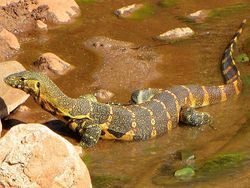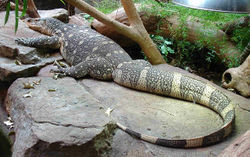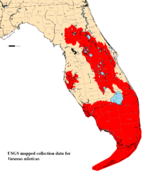Nile monitor
| Nile monitor |
|---|

|
| Scientific Classification |
| Scientific Name |
|
Varanus niloticus |
| Varanus niloticus |
Nile monitor is a species of monitor lizard known by the scientific name Varanus niloticus. They are perhaps best known as an invasive species with a greedy and relentless appetite.[2] The Nile monitor is also called different names such as the African small-grained lizard, the river leguaan, or the water leguaan. The Nile monitor, a large member of the monitor lizard family is often found near the water. They are very good at swimming. They are great climbers because of their claws. And they are also very fast runners on land.[3]
Body Design
The body design of the Nile Monitor is very unique. The nile monitors length is about is 3ft 11in to 7ft 3in in length and is also the latest specimen attaining 8ft. The average sized specimen is only 1ft 8 in. The body masses of an adult can range up to about 3.7 and 33 pounds in large monitors. [4] Nile monitors also have large claws and are very capable with handling themselves on land and water and there claws also help them climb. The Nile monitors are very eluding reptiles because they can easily escape danger with there claws. [5] The nile monitor has acute eyesight and can distinguish humans from animals and also like most reptiles they have colored vision. The nile monitors jaws are so powerful that they can crush the shells of clams, snails, and even crayfish. The body of a nile monitor is a stout bodied and is very powerful and its large large tail can be very effective if being threatened also the the nile monitor can be submerged under water for an hour. [6]
Life Cycle
The life cycle of a Nile Monitor first takes 10 months of incubation, then hatches after 129 days at the least. While they are hatching it takes about 15 minutes to 7 hours. Their development system is called intermediate growth, which means they never stop growing. They only then become mature in 3 to 4 years. Nile Monitors mating system is called polygynandrous, which means both male and female mate with several females or males.(depending on their gender) They start mating in June and then end in October, then they lay their eggs in August through September, usually laying their eggs in holes, they can also lay 20-60 eggs.[7] Once the eggs hatch, they feed off of small animals, such as snail, insects, spiders, etc. Usually, when still young, they stay together in groups, while one of them acts like a temporary leader. [8]Nile Monitors can live up to 10-20 years, but occasionally live older than 20 years. [9]
Ecology
Usually found near water, Nile monitors live their life in both aquatic and terrestrial environments. The Nile monitor's native habitat is located throughout most of sub-Saharan Africa,[7] from Somalia across to Senegal and down to northeast South Africa. It also lives along the Nile into Southern Egypt. The Nile monitor is not found in desert environments in Africa, [8]however they thrive in rivers.[2] They can live in many different habitats such as evergreen thickets, swamps, dry savanna, mangroves, scrub, and woodlands. Since they are great climbers and swimmers and can adapt to many different environments. Nile monitors make their homes in long burrows that they dig themselves or they live in abandoned burrows dug by other animals. They also can make their homes in abandoned termite mounds. [10] Nile monitors usually retreat to their burrows at night. The range of elevation at which they are found is 0 to 1,600 meters above sea level. [7]
Nile monitors are carnivores. They have a ravenous appetite. They are well known for eating anything they can find as carrion or that they can overpower. Their diet consists of many different organisms. They eat things like arthropods, fish, amphibians, birds, small mammals and other reptiles. [8]They use different strategies to hunt for their food. They usually don't shy away from challenges. They will sometimes even team up with other individuals to steal food from other larger predators. [2]Pythons, Crocodiles, leopards, eagles, and humans are all predators to the Nile monitor.Herons, predatory fish, and snakes are also predators to the Nile monitor. ,[11] They are wary when approached by humans and will run away.[7]
Invasive Species
Location and Method of Introduction Nile Monitors were introduced in the early 1990's and were first sited southwest of Cape Coral, Florida. While In Africa, They had hoped to make some money of these "exotic pets" [12] The Nile Monitors were originally introduced from Southern Africa, through pet trade. [13] They are starting to get a hold on South Florida's Palm Beach Country. They are a big problem, because they are eating the endangered species the Key Largo Rat [14] It was then thought that they were a problem in Africa, when they realized the population was too much for Africa to handle. So they decided to let them go through pet trade. Once they were spotted in Florida, they had been grown in population already. They now have three permanent breeding populations in Florida. [15]
'Environmental Impact The environmental impact that the Nile monitor has on Florida is that it mostly affects Floridas wildlife because of it's varied amount of diet the Nile Monitor eats mammals, birds, reptiles, amphibians, fish and eggs. [16]. Also the nile monitor's favorite thing to eat are young born or a burrow of eggs the problem with that is it kills a lot of egg laying species such as birds. Another problem is that the Nile Monitor can swim very well and they have extended there range to the Everglades,Cape Coral, Sanibel Island,Tampa Bay,and Key Largo. Another problem is that the Nile Monitors are very good at adapting to there environment. If they start to spread out to the rest of the United States it can cause a major wildlife problem. [17].
Control Methods A way that the population of Varanus niloticus is being controlled is for owners that can no longer care for their nile monitor pet to be responsible. If no one is willing to take care of their pet they should contact the Florida Fish and Wildlife Commission. The organization accepts exotic pets without questions. The National Wildlife Research Center is experimenting with Acetaminophen laced dead neonatal quail chicks and mouse as toxic bait.[18] The FWC identifies populations of Nile monitors and removes if possible. Officials patrol and remove sighted Nile monitors on state-owned and managed lands. In Lee county the local government operates a trapping removal program to remove sighted Nile monitors in the area.[19]
Video
Nile Monitor causing Havoc in Florida
References
- ↑ Varanus niloticus Wikispecies. Web. Month Day, Year last acessed November 7, 2016 Author Unknown.
- ↑ 2.0 2.1 2.2 S. G. Pauwels,Olivier.Nile monitor (Varanus niloticus)Wildscreen Arkive.Web.last accessed November, 2016,2016 Cite error: Invalid
<ref>tag; name "arkive" defined multiple times with different content Cite error: Invalid<ref>tag; name "arkive" defined multiple times with different content - ↑ Nile monitor Wikipedia. Web. last modified on 4 November 2016 Author Unknown
- ↑ Nile_monitor[1] last accessed October 30,2016 author unknown
- ↑ the+body+design+for+a+nile+monitor&source [2]id=bFwyw_kDfkC&pg=PA19&lpg=PA19&dq=the+body+design+for+a+nile+monitor&source=bl&ots=POzNyWClMk&sig=FyR8iqZKMR45eKc1os3DSRn8i8Q&hl=en&sa=X&ved=0ahUKEwiS7pOTzYPQAhXMlFQKHWqIAUQQ6AEIHDAA#v=onepage&q&f=false] last accessed October 30,2016 author unknown
- ↑ varanus-niloticus[3]/video-11a.html last accessed October 30,2016 author unknown
- ↑ 7.0 7.1 7.2 7.3 Szczepaniuk, Kyle.[http://animaldiversity.org/accounts/Varanus_niloticus/ Varanus niloticus
Nile Monitor, Water Leguaan] Animal Diversity. Web. last accessed October 30, 2016 Cite error: Invalid
<ref>tag; name "animal" defined multiple times with different content Cite error: Invalid<ref>tag; name "animal" defined multiple times with different content Cite error: Invalid<ref>tag; name "animal" defined multiple times with different content - ↑ 8.0 8.1 8.2 Dlamini, Nontuthuko. Nile monitor SANBI. Web. last updated January 21,2016 Cite error: Invalid
<ref>tag; name "sanbi" defined multiple times with different content Cite error: Invalid<ref>tag; name "sanbi" defined multiple times with different content - ↑ Kruzer,Adrienne. Nile MonitorsExotic Pets. Web. last edited October 23, 2016
- ↑ [4]WAZA. Web.last accessed October 30,2016 Unknown Author
- ↑ [5]Swich Zoo.Web.last accessed october 30,2016 Author Unknown
- ↑ .[6]Cape Coral. Web. Last visited November 7,2016. Unknown Author.
- ↑ .[7]Nonnatives. Web. Last accessed November 7,2016. Author Unknown
- ↑ Hill, Taylor.[8]. Web. Last edited April 13,2015
- ↑ Yong, Ed.[9]The Atlantic. Web. Last edited April 20,2016
- ↑ ."Nile Monitor Concerns"http://myfwc.com/wildlifehabitats/nonnatives/reptiles/nile-monitor/].Web. Last accessed November 7,2016. Author Unknown
- ↑ .Decoded Science"R. Wetzel.[10]. Web.Last edited July 13,2011
- ↑ Wetzel, David R. Nile Monitor Lizards: Invasive Species in Florida Threatens Native Species Decoded Science. Web. last accessed November 7 2016
- ↑ Nonnatives - Nile Monitor Fish and Wildlife Conservation Commission last accessed November 7, 2016 Unknown Author





